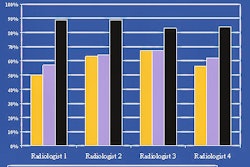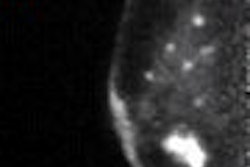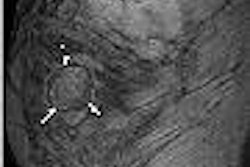The expression "once bitten, twice shy" applies to breast imaging specialists who have survived some form of malpractice litigation -- these radiologists are apt to overestimate their future risk of being sued, and believe that their practice patterns are influenced by that potential risk, according to a survey in Radiology. But does this apprehension actually affect their interpretative performance and patient recall rates?
While it's common knowledge that the payout for mammography-related malpractice litigation is high (the average indemnity payment was $438,000 in 2002), less is known about how radiologists perceive the malpractice environment, according to Dr. Joann Elmore and colleagues.
Elmore is from the University of Washington and Harborview Medical Center in Seattle. Her co-authors included Patricia Carney, Ph.D., principal investigator for the New Hampshire Mammography Network (NHMN), and Dr. Carl D'Orsi, director of the Breast Imaging Center at Emory University in Atlanta.
"We hypothesized that greater perceptive concerns and previous medical malpractice experiences would be associated with higher recall rates," wrote Elmore's multi-institutional group (Radiology, July 2005, Vol. 236:4, pp. 37-46).
For this study, data was collected from three U.S. registries: the NHMN, the Group Health Cooperative Breast Cancer Surveillance System in Washington, and the Colorado Mammography Project.
Radiologists from the three registries were eligible for the survey if they had interpreted mammograms between January 2001 and December 2001. These 181 physicians were sent a 10-minute, four-page survey with a framework that incorporated Bandura's social cognitive theory. This theory asserts that behavior is influenced by an interaction of attitudes, beliefs, and environment, the authors explained.
The survey response rate was 76.8%, or 139 out of 181. Of these, 124 had interpreted 480 or more total screening mammograms. The majority of the respondents were male (77.4%), worked full-time (74%), and had more than a decade of experience in breast imaging (77.2%).
According to the results, 52.5% reported a prior medical malpractice claim, 14.8% of which were related to mammography. These included alleged misinterpretation of a mammogram or an ultrasound exam. Not surprisingly, 81% of those who had been sued reported that the experience was very stressful.
Nearly three-fourths of the respondents (72.4%) said that their concern about malpractice claims moderately or greatly increased the number of recommendations for diagnostic mammography and/or ultrasound exams. In addition, more than half (58.5%) said that these concerns increased the number of recommendations for breast biopsies.
In terms of recall rates, they ranged from 1.8% to 26.2%, with evidence that the radiologists who reported prior, nonmammography-related claims stated a lower recall rate (8.9%) than those who had never had a claim (11.2%).
Still, the fear of being sued turned out to be more pervasive than the reality. A little more than 80% of those surveyed estimated there was at least a 10% chance that they would be sued in the next five years.
"In actuality, among radiologists who had been practicing for at least five years, only 8.9% reported that a mammography-related claim was filed against them," the authors pointed out. In this latter group, the radiologists estimated that there was a 50% or higher chance that they would be sued again in the next five years.
While radiologists with the highest perception of malpractice risk also reported higher levels of influence on their practice, the authors stressed that "no direct association was noted between radiologists who reported concern about medical malpractice and their recall rates in actual practice."
But prior research has shown that recall rates have been on the rise for some time, and that U.S. doctors turn in higher recall rates than physicians in other countries (New England Journal of Medicine, April 16, 1998, Vol. 338:16, pp. 1089-1096; Journal of the American Medical Association, October 22, 2003, Vol. 290:16, pp. 2129-2137).
Elmore's group offered two possible reasons for this: either those surveyed overestimated the effect of malpractice or all physicians, regardless of whether they had been sued, were practicing defensive medicine.
"The trade-off between missing a cancer and calling too many women back for diagnostic evaluation is a challenging balance that may currently be influenced by malpractice concerns," the authors wrote. "One question this research raises is whether the heightened level of malpractice concern of practicing U.S. radiologists may lead to future workforce problems."
In fact, many of those who participated in the survey said that they were rethinking a career in breast imaging, either by cutting back on their mammography reading schedule or withdrawing completely from the field.
By Shalmali Pal
AuntMinnie.com staff writer
June 28, 2005
To read a commentary on this study, click here.
Related Reading
Breast imaging trends show longer waits for screening mammo, more biopsies, May 6, 2005
Breast biopsy costs big bucks, but so does cancer screening, January 19, 2005
Bringing residents back to breast imaging: An insider's perspective, October 16, 2003
Malpractice fears may initiate more false-positive mammograms in North America, September 6, 2003
Copyright © 2005 AuntMinnie.com



















